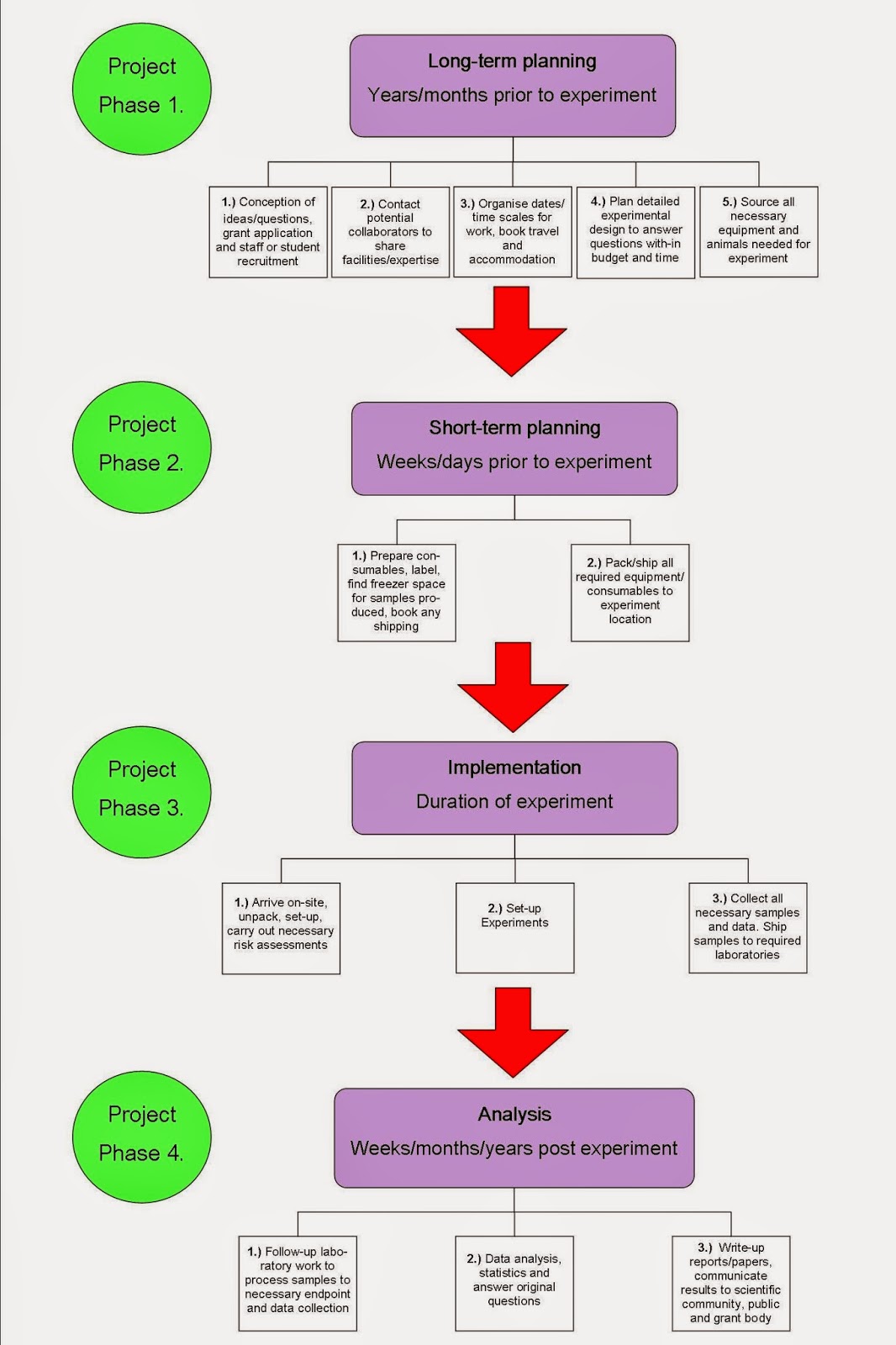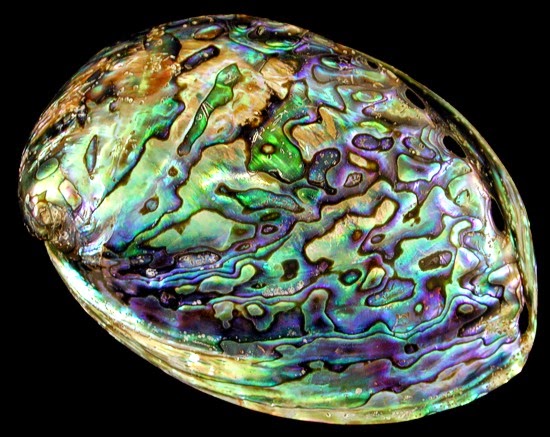Science and Logistics
SCIENCE AND LOGISTICS
When it comes to science projects, the importance of
logistics should never be underestimated. From the conception of ideas/questions,
through project implementation and the final results, analysis and
publications; in order for the project to successfully run from start to finish
a highly skilled, logistically-minded project manager and team are required. I’ve
tried to summarise the typical steps involved in an experimental biology
project in a simple flowchart (figure 1) – it looks straight forward – right?
 | |||
| FIGURE 1. Flowchart of typical project phases |
Before starting a PhD project, there is often little opportunity
to practise the skills required for successful project management. I was
fortunate enough to have been involved in snapshots of projects throughout my
degree. I dabbled in idea development, grant writing, experiment implementation,
sample processing, data analysis and writing papers. Yet only once did I manage
to engage with all necessary phases in one single project, the mighty honours
project of course. I started planning my honours project in early spring 2012,
and now, late summer 2014 I am still working on the manuscript and waiting for collaborator
inputs before the work can be published – it’s a lengthy process. One important
skill developed during a PhD studentship is project management. Each student is
responsible for the success of their own projects, and the student alone (with
the support of supervisors) has to ensure end-products (reports and a thesis),
or answers to scientific questions, are reached.
To demonstrate the amount of work and planning which is
required in a single project, I’ll sum-up a small case study. I’m currently running experiments on shellfish;
my experiments integrate into a network of science on the theme of mollusc
shells. Using the flowchart in figure 1 as a framework, I’ll outline some of
the processes involved in a single project within my PhD.
Phase 1. Long-term planning
About four years ago my supervisor, Dr Melody Clark, became
interested in how molluscs build their shells. Melody contacted potential collaborators,
wrote grant applications (both NERC and Marie Curie) and successfully won money
to carry out the science. She advertised PhD studentship positions, sifted through
hundreds of applications, interviewed several candidates and now co-ordinates a
multi-disciplinary team of researchers working on shellfish. I am one of Melody’s
PhD students on a NERC studentship grant, I started my project in October 2013,
and I’m specifically interested in how Antarctic and temperate clams build
their shells - on a molecular level.
One element of my PhD project is damage-repair experiments
on clams. Melody has another student , Teja, who is a Marie Curie fellow and does
damage-repair on commercial species - mussles, scallops and oysters. Together the three of us need to visit a
collaborator institution, the Scottish Association of Marine Science (SAMs)- in
Oban north west Scotland, to carry out simultaneous damage-repair experiments
on four shellfish species. First things first, when are we going to do the
experiments? How are we going to get to Scotland? And where are we going to
stay during the experiments? Okay fairly straight forward, we need to do the
experiments in summer because that is when one of the species (the clam Mya arenaria) is visible in the mud to
collect; we’ll get the train up to Scotland; and we’ll stay in an apartment.
How will we get around while we’re in Oban? We’ll hire a car and borrow
push-bikes. No problem – next decision. One of the most important decisions to
make during any scientific project concerns experimental design. How exactly
will we carry-out the experiments in order to answer the questions we’re
interested in? What time-points are we most interested in? How many samples can
we afford to process? How much time can we afford to spend in Scotland? How
many individual animals do we need to be able to do robust statistics? After
several lengthy discussions between Melody, myself and our collaborators in
Cambridge and Scotland, an experimental design was agreed. Finally we need to
source the animals for the experiment. The commercial species can be ordered in
from local shellfish farms, but the clams will have to be hand-collected by myself
and the SAMs dive team. All sorted. Long-term planning is complete
approximately 6 weeks prior to experiments commence.
Phase 2. Short-term
planning
We have four species, a total of 580 animals, 290 holes to
drill and 1860 samples to take. All of which equates to tonnes of labelling; more
specifically sensible labelling, so each sample has a unique I.D. which can be
tracked throughout the experiment, processing and data analysis. Once all the
consumables are labelled and all the equipment has arrived (drills, drill bits,
probes, callipers, dry-shippers etc etc) they need to be packed and shipped up
to Scotland so everything is there ready for when we arrive. Another thing we
need to do is draft a potential schedule for experiment set-up and sampling.
We need a rough idea of where we will need to be and when. The most important
thing about this schedule, however, is that it needs to be flexible. The work
is unlikely to go exactly to plan, therefore the schedule needs room to chop
and change where required. Consumables labelled, packed and shipped – we’re
almost ready. Short-term planning is complete a few days before the experiment
is due to start.
Phase 3.
Implementation
 |
| Me drilling one of many holes on day two |
 |
| Melody and Teja drilling |
After a ten hour train journey, with four changes, Melody,
Teja and I arrive a little jaded into our apartment. Day one’s priorities are
to get the hire car, unpack all our pre-shipped equipment, get settled into an office,
get our heads around the aquarium layout –what tanks we can use and where, meet
our host scientists and generally find our feet. Day two is when the fun
begins. We drilled 290 holes in two experiment locations. Day three – sampling commences.
All samples need to be taken and stored in the correctly labelled consumables,
frozen using liquid nitrogen and kept in the -80°C freezer. On top of taking
samples, we need to keep track of the physical conditions in our experiments
such as dissolved oxygen, temperature and salinity. The experiments will last
at least two months, with sampling time points spread out over the weeks. Once
the experiment is set-up and we have an efficient routine for sampling, we can
take it turns to make the trip up to Scotland to sample. All the samples need
to be shipped back to Cambridge for further processing. Experiment implementation
is complete in just over 2 months.
 |
| Melody's sampling masterclass on day three |
Phase 4. Analysis
 |
| Drying shells for analysis |
For our project, the follow-up laboratory work has the
potential to be as lengthy as the implementation. All samples need to have
either RNA, DNA or protein extracted, cleaned and analysed before being sent
off for sequencing. Once all the data is acquired, it is down to Teja and
myself to carry out analysis. Again, not a straight forward task. This is the
phase of the project when we start to get the answers to the scientific
questions we outlined in phase 1. Once we are sure of what the data is showing,
the experiment results are written-up into reports and journal articles. It is
also important to tell the general public what we have found out using various
channels of communication (see previous blog: communication matters). Several
years after the original ideas for our projects were conceived, thousands of
hours work completed and countless sleepless nights later, the project is
complete. (n.b. Hopefully this phase is actually completed - currently we're still in the midst of implementation)
Ifs, buts and changes
of plan
Whilst this case study clearly shows a lot of work and
planning goes into any project, I have purposefully skipped over all the
disasters, changes of plan and general hardships which happen on any project.
Unfortunately , projects don’t go smoothly according to the flow diagram. Here
are just some of the issues which have been overcome on the project so far:
· The first student started a PhD on shells in
2011, but decided to leave, which meant there was another round of recruitment,
delaying the project by another year... But ultimately lead to my appointment in
October 2013 so I can’t complain about this little mishap.
· Due to issues in the HR Department, Teja’s work
permit was delayed and she couldn’t start work until August 2014, which
dictates the experiments have to happen in August 2014.
· August is peak tourist month in Oban so all accommodation
was booked up, but we managed to secure a last minute apartment with no WiFi.
 |
| It's definitely Mya, but can you tell which species? |
· The clams, Mya
arenaria, remained elusive for weeks. They finally showed up, but were very
time consuming for the dive team to collect. Once we arrived on-site we only
had 22 clams – not the 100 we wanted - and they were the wrong species. The Mya experiment will have to be staggered
and set-up as/when the animals come in.
·
The oyster species we want to work on are
invasive and we must avoid being responsible for introducing them into Oban
Bay, therefore we have to drive 1.5 hrs each way to a site on Loch Fyne to
carry out the work; taking with us a dry shipper containing liquid nitrogen to
freeze the samples.
 |
| Protective over-shoes to prevent the introduction of invasive species |
· The car hire company won’t let me drive because I
have had my license for less than 2 years. So we’re down to 2 drivers – and Teja
only has an automatic license.
· The drill bits we wanted to use for making holes
in the shells, and which we had plenty of spares , were inappropriate for the
job and we had to change onto standard bits. The drills kept running out of
battery power with lengthy recharge times, significantly challenging our plans
to get all the drilling done in one day.
 |
| Teja and I enjoying sampling on Loch Fyne |
 |
| Melody and I having a well earned rest after a day of drilling |
Project work is
challenging. It’s a process I can only describe as dynamic. But it’s great fun
and the standard way to do science. The trick is to be flexible, and
be organised; go with the flow and try to enjoy ride.
 |
| The most important part of planning... Make sure there's time for an ice cream at the end of the day :-) |


Comments
Post a Comment